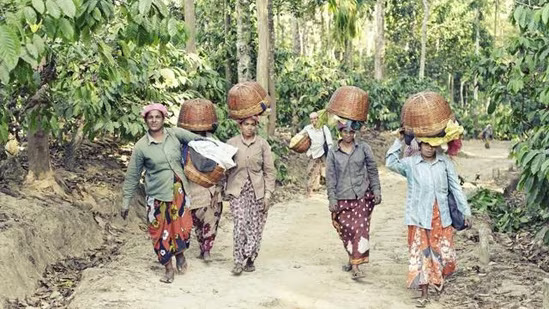As Wayanad faces devastating landslides, it’s time for Kerala to reconsider its monoculture plantations.
While Wayanad is celebrated as a green paradise among tourists, it is also criticised by environmentalists as a green desert due to its extensive tea plantations, which offer limited biodiversity. The district’s recent landslides were triggered by torrential rainfall but the role of change in land use and monocropping cannot be ruled out.
Tea plantations in agricultural lands and teak and other cash crops in forestry are prime examples of monocropping in Wayanad.
A 2017 study from Japan suggests that ‘biodiversity is likely associated with shallow landslide risk reduction, emphasising a possible reduction of spatial and temporal uncertainty in the roles of woody vegetation.’ Although there are no direct scientific studies linking monoculture to landslides in India, environmentalists observing these patterns suggest a potential connection.
“The 2018 landslide at Wayanad was caused at the edge of a tea plantation. The roots of tea plants cannot bind to soil. The lower region of Wayanad which consists of tea plantations cannot hold the soil causing turbulence in the upper region,” said C K Vishnu Das, director, Hume Centre for Ecology and Wildlife Biology. A 2021 study from Kerala found out that the soil in the monoculture tree plantations has lesser soil organic carbon (the ability of the soil to hold carbon) after being converted from natural vegetation. Monoculture tree plantations have a two-fold impact globally: Loss of biodiversity and net emitters of carbon.
Researchers suggest that landslides may result from a combination of anthropogenic activities and geological factors. “Landslides can be triggered by geological issues like soil piping. Wayanad’s hilly terrain, with its thin soil layer, becomes highly vulnerable to disasters when altered by unplanned agricultural practices,” explained Vijo T. Kurien, who led the 2021 study on monoculture plantations in Kerala.
Plants with fibrous root systems, like tea, struggle to hold soil effectively. “While monoculture may not be the primary cause, it certainly contributes to soil instability,” he said, urging the state government to promote polyculture, especially in Kerala’s most vulnerable regions.
“Monoculture plantations are a significant factor contributing to land susceptibility to landslides. In tea plantations, soil erosion poses one of the most serious ecological threats,” said V Shakeela, the Community Agrobiodiversity Centre director, MS Swaminathan Research Foundation, in Wayanad.
Why monoculture?
Monocrops lead to reduced biodiversity and increased vulnerability to environmental stress. On the other hand, monoculture has been integral to many families’ livelihoods for generations. Kerala accounted for 72% of India’s rubber production, 91% of cardamom, 20.4% of coffee and 4.5% of tea in 2021-22. Kerala promoted the plantation sector due to the sector’s contribution towards foreign exchange and to uplift the livelihood of workers, as mentioned in a 2013 study.
“Once famous for homestead gardens, Kerala opted for monoculture after industrial agriculture took off globally. Cash crops such as rubber, coconut, areca nut, tea and pepper were grown heavily,” said Shakeela.
Monoculture makes agriculture profitable. “The labour cost in Kerala is the highest in the country. Monoculture helps farmers reduce their input cost and is also easy to mechanize,” Shakeela added.
Introduced by the East India Company in 1853, tea estates in Wayanad pose farming challenges. “Unlike coffee plantations, which can support diverse indigenous trees like jackfruit and tamarind, tea estates cannot accommodate such diversity,” Shakeela added. The daily harvest of tea leaves makes crop diversification unfeasible and affects the possibility of including shade-providing trees, which can impact yields.
Way forward
In February 2024, the Union commerce and industry ministry granted approval to raise the subsidy to plant or re-plant rubber from the current amount of Rs.25,000 to Rs.40,000 in Kerala. The tea fertiliser subsidy has been increased from ₹2000 to ₹4000 a week ago.
Monoculture reaps economic benefits for farmers. As per the Kerala state biodiversity strategies and action plan 2022-32, the state is set on encouraging a multiple cropping system in homesteads. “With regard to food diversity, especially of the tribal/ethnic communities, green leaves and other vegetables and tubers, which are potential for nutritional and health security are to be evaluated scientifically and popularised,” the report mentioned,
Experts say that these strategies have not been translated on the ground level. “While the action plan aims to promote polyculture, there are no policies in the state for the same,” said Badusha.
Organisations like MSSRF are championing agroforestry. “We hold regular training sessions to educate farmers about sustainable agriculture practices. To encourage a shift towards poly cropping, we provide free seeds of various traditional vegetable varieties. We also recognise and award farmers who are dedicated to conservation,” said Shakeela.
In a few fragments, farmers like Sukumaran Unni are focusing on cultivating only indigenous polycrops. “Monoculture has never been a part of Indian agriculture. On my five-acre farm, I grow a diverse range of crops including coffee, pepper, turmeric, and ginger,” he told Hindustan Times.






